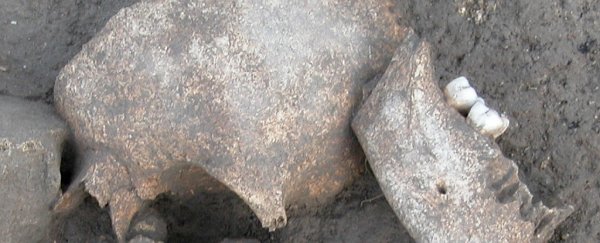According to historical accounts, the ancient Gauls of Europe 2,000 years ago had a grisly means of commemorating their most prestigious kills: they would embalm the severed heads of these foes, and keep them.
Now, for the first time, science has proven that the Gauls did indeed embalm severed heads.
The Gauls were fearsome warriors, and their bedevilment of the Roman Empire was legendary. It was by defeating the Gauls that Julius Caesar boosted himself into power, but they troubled west and central Europe for centuries until they were ultimately absorbed into Rome in the 1st century CE.
Historical documents speak of their ferocity, including their practice of embalming the heads of their foes - but until now, we had no historical proof beyond such texts.
"The heads of their most distinguished enemies they embalm in cedar-oil and carefully preserve in a chest, and these they exhibit to strangers, gravely maintaining that in exchange for this head some one of their ancestors, or their father, or the man himself, refused the offer of a great sum of money," wrote Greek historian Diodorus Siculus in the fifth volume of his Library of History, 60-30 BCE.
And Greek-born Roman historian Strabo wrote in his Geography, published 7 BCE: "The heads of enemies of high repute, however, they used to embalm in cedar-oil and exhibit to strangers, and they would not deign to give them back even for a ransom of an equal weight of gold."
The problem is that the Greeks and Romans were enemies to the Gauls, and an enemy can never be entirely trusted to give an honest account.
So researchers from the Archaeology Laboratory of Mediterranean Societies and the IMBE research institute decided to ask a primary source - those severed heads themselves, recovered from an archaeological excavation site in Cailar, in the south of France.
Obviously, 2,000-year-old skulls can't actually talk. But they can retain evidence of their history.
The research team took samples from 11 retrieved skulls that showed signs of decapitation trauma and brain removal, and ran chemical analyses of the substances remnant on their surfaces.
As a control, they also performed the same tests on animal bones that were found at the same site.
"The results reveal that some of the samples analysed contain conifer resin biomarkers and aromatic compound molecules obtained only when the resin of trees in the pine family is heated to high temperatures," stated the French National Center for Scientific Research, one of the organisations collaborating on the research.
Six of the skulls - and none of the control animal bones - were positive for diterpenoic compounds (found in conifer resin), degradation products of abietic acid (also found in conifer resin) and biomarkers of conifer resin.
The researchers were unable to say if the conifer resin was specifically from cedar trees, nor whether the skulls belonged to high-ranking foes of the Gauls, but the evidence does indeed point to deliberate decapitation and embalming.
Further study, the researchers note, could help determine whether other aspects of the historical accounts are true.
"A question for further research arising from this study is whether or not this specific practice actually began in the early 3rd century BCE or at the end of the 4th century BCE," they wrote in their paper.
"We also have to question if the skulls came solely from the enemies or also from the ancestors at the same time, as is recorded in head hunting societies. Finally, we have to determine if the process was used for all the heads or only part of them."
The research was published in the Journal of Archaeological Science.
